SEO For Photographers
Published April 2, 2022

First.. What is SEO??
SEO stands for Search Engine Optimization.
Search engines (like Google) evaluate your online presence and give you a score in various categories. The goal of SEO is to understand the scoring system and improve your score in as many categories as possible.
Real quick.. Who Are We?
Fuel Your Photos
Meet Dylan Howell and Corey Potter.
We both started our careers as photographers, before expanding into websites and SEO.
We’ve helped thousands of photographers learn SEO techniques and worked on hundreds of photography sites.
Our goal is to make SEO and other online marketing strategies digestible and actionable for people of all technical backgrounds. We don’t think you need to learn SEO on an academic level, but you are likely to be able to benefit from getting your hands dirty with these techniques.
We simply know what works and we’ll skip all of the marketing talk, fluff bullet points, and time-wasting or outdated strategies. Let’s dive straight in.

11 Easy SEO Tips for Photographers!
1. Basic Keyword Research
2. Perfect Your Page Titles
3. Organize Your Headings
4. Create and Complete Your Google Business Profile
5. Perform a site: Search
6. Analyze Your Competition
7. Create Content
8. Build Backlinks by Guest Posting
9. Optimize Your Images
10. Verify Search Console
11. Study Free SEO Resources
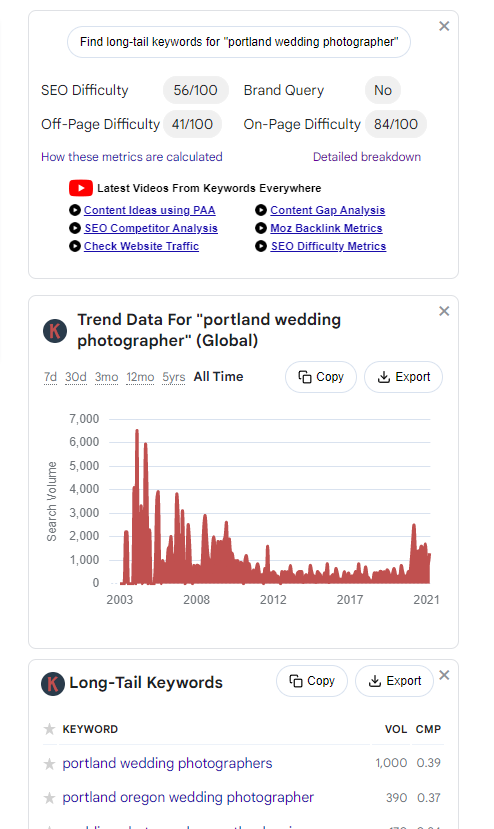
1. Basic Keyword Research
Keyword Research tools are typically quite expensive, but we have a favorite that is both affordable and accurate enough to use on the typical photography site. It is called Keywords Everywhere and it is a browser extension for either Chrome or Firefox.
For keyword research, you can build a spreadsheet of target terms, related keywords, long-tail keywords, and people-also-ask keywords. You can use this data to decide on your homepage keyword and build a content strategy for your blog and other pages.
You can see this data straight from Google Results or export to a spreadsheet for easy organization.
Top Places to Put Keywords
- Page Title – The title should be the main point of the page, include the main keyword you are targeting, and be compelling to click!
- Meta Description – Keywords in the meta description won’t improve rankings, but they will be bold in the search results. This can improve click through rate.
- H1 Heading – Your headings give users and search engines a better idea of the content of your site. The H1 heading is typically a sign that it is the overall topic for that page.
- Image Alt Text – While you shouldn’t stuff alt text purely for ranking purposes, you can usually get your main keywords into the alt text of at least a few relevant images on each page.
- Body Copy – Don’t forget to use your target topic in your body text organically.
2. Perfect Your Page Titles
There are two common issues with page titles:
- They are too long or significantly over optimized
- They are not optimized at all (eg. “Home”)
The simplest formula for a home page title is:
“Your Business Name: Main Keyword” or “Main Keyword | Your Business Name”
When it comes to length, use this tool: https://mangools.com/free-seo-tools/serp-simulator
You don’t need to stuff the title with keywords, repeat variations of the keyword, or try to get
many locations or specialties into one title. The more specific you can be, the more effective
your title will be.
Pro Tip: grouping phrases together allows Google to be more confident that the words
belong together.
For example, “Newborn and Family Photographer in Columbia, SC” prioritizes
“Family Photographer in Columbia SC” as a keyword phrase.
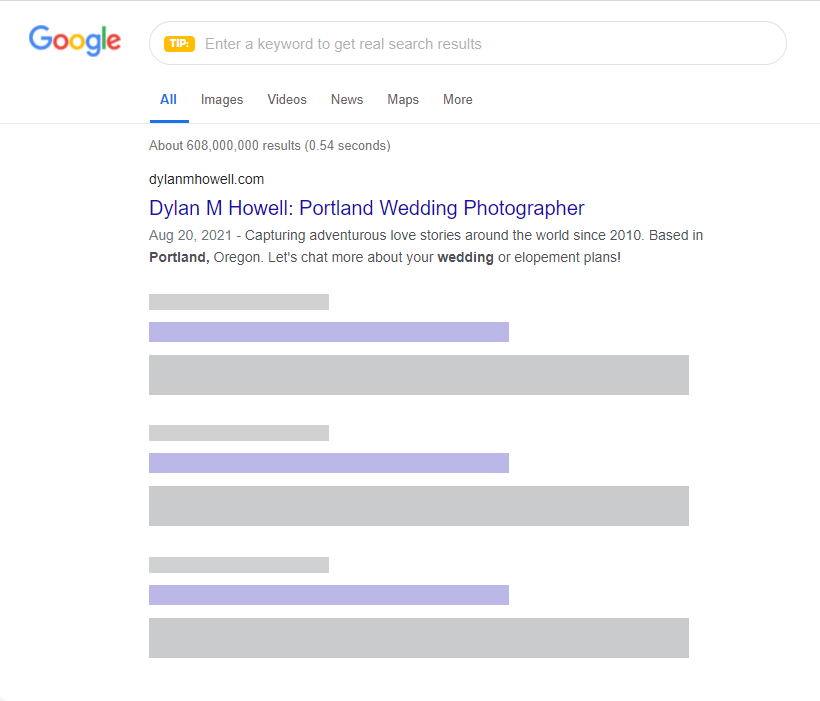
3. Organize Your Headings
Headings are quite important for showing your content structure to Google and users. Think of your headings as the outline to your content.
The browser extension, HeadingsMap, makes this quite easy to see and fix.
Here is a quick video that goes into more detail!
4. Create and Complete Your Google Business Profile
If the location you’re targeting shows Google Map results, creating a Google Business profile is the first step to appearing on that list!
Google Business is the way you’ll give Google official information about your business that can be displayed in map searches, and in the “map pack” on organic searches. It is also where you’ll collect Google reviews for your business.
The best general advice that we can give is to fill out every piece of information that applies to your business, and to keep your information and photos up to date (update the photos at least 2 times a year).
Here are the official guidelines on Google Business profiles: https://support.google.com/business/answer/3038177?hl=en
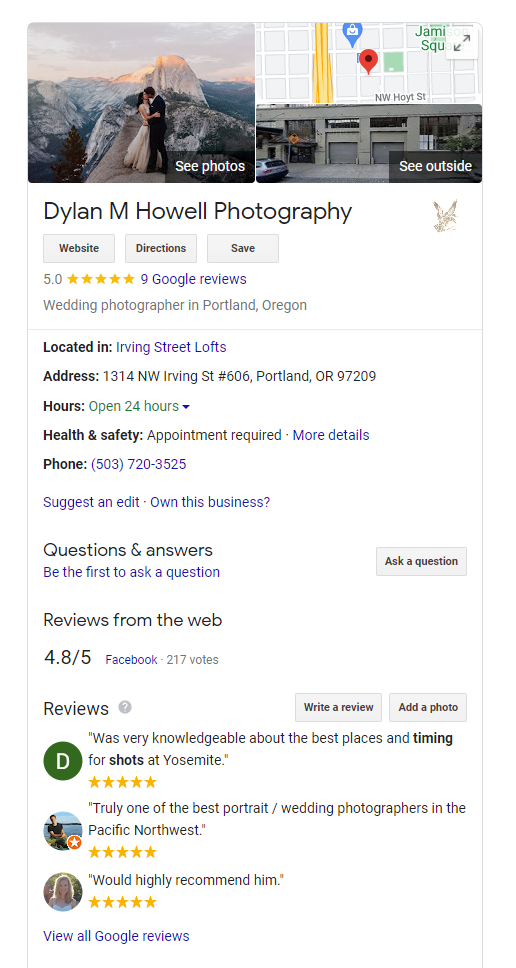
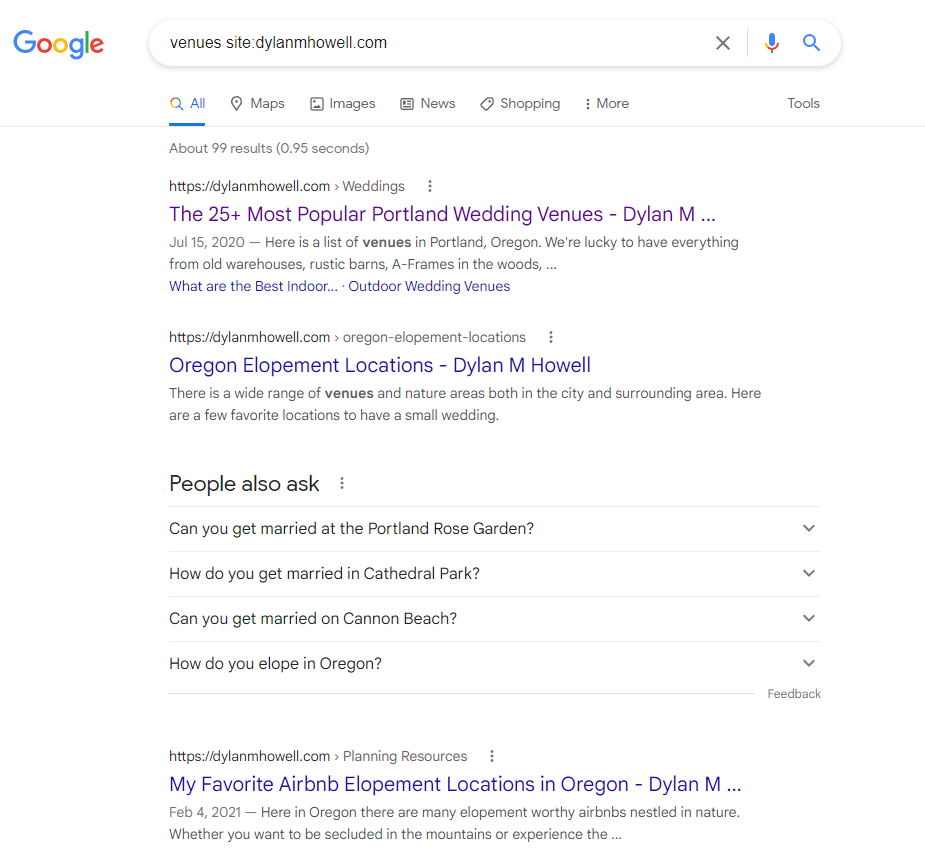
5. Perform a site: Search
There are many ways to use the “site:yourdomain.com” search operator to improve your SEO.
A quick indexation check: doing a site: search with no added keywords will give a close approximation to the total number of pages on your site that are indexed. You can also use specific URLs to quickly see if they’re indexed.
Check for competing content: By adding a target topic or keyword, you can see if there are multiple pages on your site that are competing to rank for the same topic. These can be easy fixes to improve rankings, by clearly optimizing one page for that topic or term.
Easily see low quality content: A site: search is often the quickest way to spot low quality pages that are indexed. These include image attachment pages, tag archives, category archives, duplicate pages, template/theme example pages, etc.
There are even more ways to use the site: search to improve your SEO, we have a podcast that goes deeper into the tool here: https://www.fuelyourphotos.com/podcast/episode-26-site-search-operator/
6. Analyze Your Competition
Yet another tip that utilizes the Keywords Everywhere browser extension.
You can hover your mouse over the keyword metrics for a competitor’s site, then click “view top pages”.
This will give you a list of their top pages, sorted by estimated organic traffic. From there, you can click on each individual URL and see a list of the keywords that they rank for!
This can be a great way to get content ideas from a handful of competing or authoritative sites on the same topic you’re targeting.
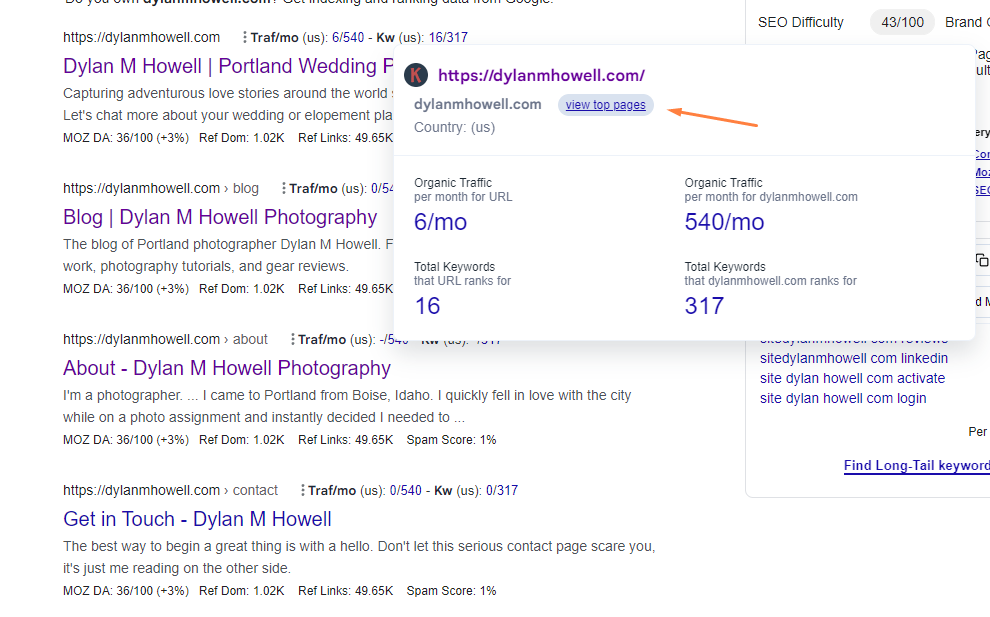
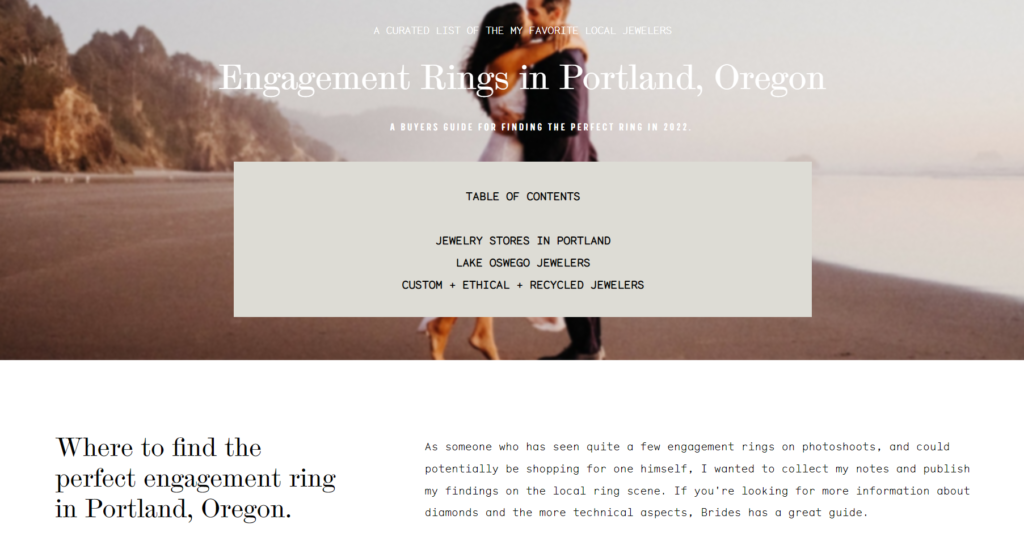
7. Create Content
Put yourself in the shoes of your potential clients.
What questions are they asking? What research are they doing before booking a photographer?
If you can create content that provides value by answering those questions, you will not only improve your traffic from search engines.. but show yourself to be an expert on the topics covered.
Here are 200+ ideas!
We have an entire section of our course dedicated to this topic, if you’d like to learn more!
8. Building Backlinks – Guest Posting
Links from other sites to yours will likely improve your rankings. Google originally built its algorithm based almost entirely on backlinks. Now, 24 years later, more backlinks still correlate with improved rankings.
Guest Posts are one of the best ways to build authority.
The idea is to trade your knowledge and expertise for access to a larger audience and more powerful domain. This can allow you to rank for terms on their site that are simply not attainable on your own.
It is also a place where you can naturally link back to your website and content.
These relationships can be quite powerful and help your business outside of just Google rankings and site traffic. Pitch a guest article idea to a blog, local company, or other associated business today!
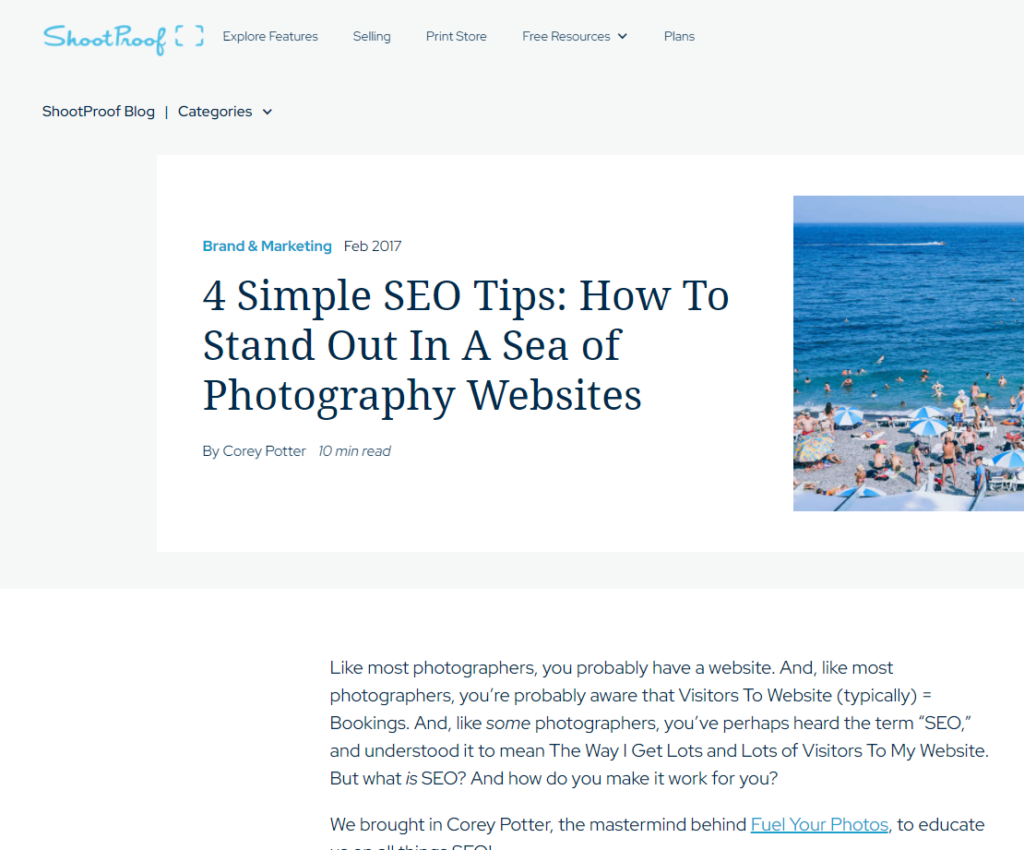
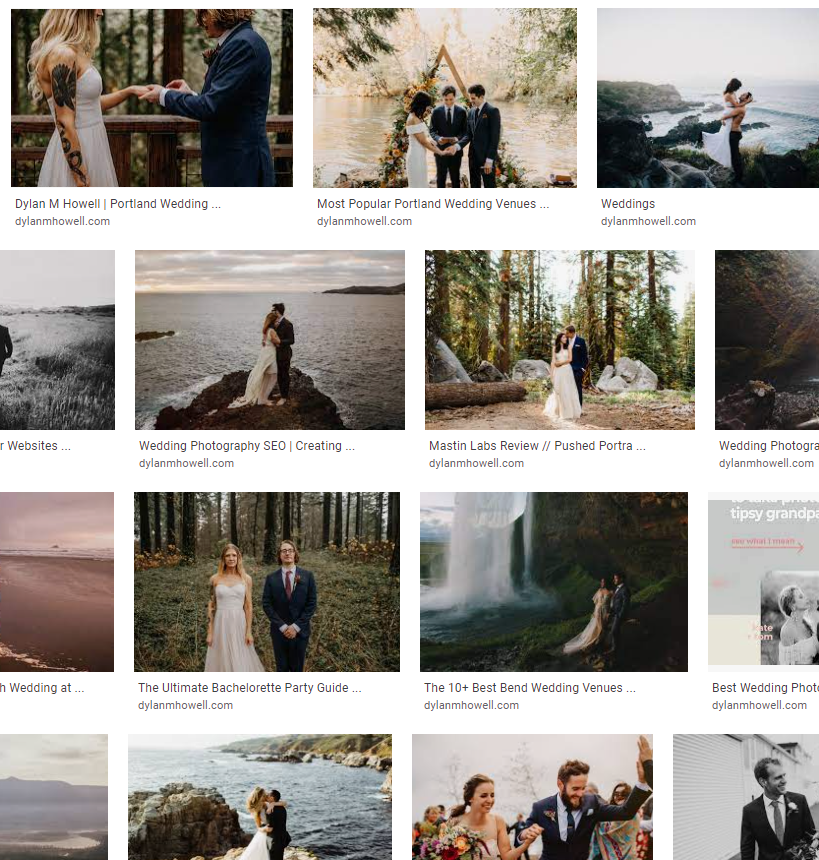
9. Optimize Your Images
On important pages, you should be using keyword rich filenames for your images when possible. These filenames should match both the content of the image and the surrounding text content topic for best results.
Example:
On my homepage, it’s great to have: portland-wedding-photographer.jpg, portland-wedding-photographer-2.jpg, oregon-wedding.jpg, etc
Alt Text Tips:
You should follow accessibility best practices and make sure to include alt text on any images that add context to your content or is needed to navigate and understand your site.
Make sure to use short and descriptive text that gives context to the contents of the image. Don’t add “photo of” or “image containing” to the start.
Here’s our full guide to Alt Text for photographers (with examples).
Compress Your Images Properly!
Your image files should be compressed quite heavily for web use. This should not affect the visual quality of your images, but will drastically improve website performance.
A simple workflow would be to simply export from Lightroom at ~70 quality.
We also recommend a compression tool called Shortpixel, when used on the Glossy setting. This tool has both a WordPress plugin and a web based compression tool for other platforms.
For more information, see our full guide to image optimization:
10. Verify Search Console
This is where you can track your progress and see your site’s performance in Google search.
In order to start collecting data, you must verify your website. The best way is to verify your “Domain Property” through your domain registrar. This will show information for your entire domain.
Once you’re verified, you can submit your sitemap(s). This is a one-time action that will allow Google to quickly see your newly published content and begin the crawling and indexation process.
There are many useful reports and tools inside of Search Console, but few are needed at this stage in the process.

11. Study Free SEO Resources
These are great beginners guides to SEO. They will allow you to dive deeper into the theory and technical aspects of SEO that we’ve intentionally left out of this guide.
Ready for more? Check out the Fuel Your Photos Membership!
Our SEO course gives you the foundation you need
12 assignments covering the fundamentals of SEO (plus lots of other members only content). By the time you finish the course, you should have a solid SEO foundation + a content plan that lets you continue to increase traffic from search over time.
Join a supportive community
We have a community of photographers who are serious about building better websites and getting traffic from search engines. We also go live in the group multiple times each month to help people get unstuck, and to talk about what is currently working in photography SEO.
WE CARE ABOUT YOUR RESULTS.
This membership is designed to get you results. It isn’t one method that worked for one photographer, it is comprised of the techniques we’ve seen work most consistently.

Ask Your SEO Questions
Have even more questions that weren’t answered in the guide? Leave a comment here and if your question is selected, we’ll answer it so others can also benefit! You can also join our free Facebook group to have a discussion with the community!



Hey this bit: “Check for competing content: By adding a target topic or keyword, you can see if there are multiple pages on your site that are competing to rank for the same topic. These can be easy fixes to improve rankings, by clearly optimizing one page for that topic or term.”
How do add a keyword? After the site:mysite.com?
correct: either before or after works.
example: term site:mysite.com
Hey this bit – “On my homepage, it’s great to have: portland-wedding-photographer.jpg, portland-wedding-photographer-2.jpg, oregon-wedding.jpg, etc”
Is Portland wedding photographer.jpg a photo of the photographer or a wedding photo?
You’ll typically want to rank with a portfolio image of a couple in that example!
I check my competition and some sites that rank higher than me are slower and have a lower domain rating?
There are many more factors! Local factors (reviews, citations, map searches), Authority factors (unlinked mentions, branded search), Relevance factors (intent fit, content quality, topical authority)